The first step of this puzzle involves adjusting clocks to discover different historical time zones across the globe. The canonical resource for tracking time zones is the tz database, also known as zoneinfo or the Olson database, maintained by IANA (version 2021c as of this hunt; see the Author's Notes for more stories). Each timezone is named after a city, often a national or regional capital. We can use differences in daylight savings time offsets, local mean time, and other historical quirks to determine which clock comes from which city.
| Clock Number | Timezone | City |
|---|---|---|
| 1 | Asia/Anadyr | Anadyr, Russia |
| 2 | Asia/Baku | Baku, Azerbaijan |
| 3 | America/Argentina/Buenos_Aires | Buenos Aires, Argentina |
| 4 | Africa/Cairo | Cairo, Egypt |
| 5 | America/Detroit | Detroit, USA |
| 6 | America/Iqaluit | Iqaluit, Canada |
| 7 | Asia/Irkutsk | Irkutsk, Russia |
| 8 | Europe/Madrid | Madrid, Spain |
| 9 | Asia/Manila | Manila, Philippines |
| 10 | Australia/Melbourne | Melbourne, Australia |
| 11 | America/Indiana/Tell_City | Tell City, Indiana, USA |
Once we have identified the cities, we can use the poster tube labels, which describe flags/coats of arms of the cities that the clocks are from. Identifying them and filling in the missing information about each flag allows us to take the numbered boxes in order and extract the final cluephase, WATCHMAN OR SENTINEL (FIVE). Solving this cluephrase yields the final answer, GUARD.
| City | Flag Image | Poster Tube Label |
|---|---|---|
| Madrid | 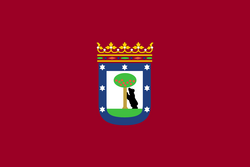 | A BEAR LEANING AGAINST A STRAWBERRY TREE |
| Melbourne | 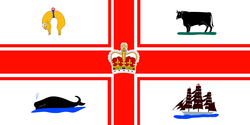 | A FLEECE, A BLACK BULL, A SPOUTING WHALE, AND A THREE-MASTED SHIP |
| Iqaluit | 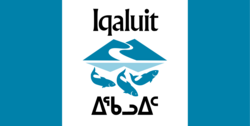 | A MOUNTAIN WITH A RIVER ALONG IT AND THREE FISH BELOW IT |
| Manila | 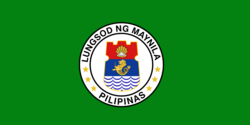 | A PEARL IN AN OYSTER ABOVE A SEA-LION HOLDING A SWORD |
| Anadyr | 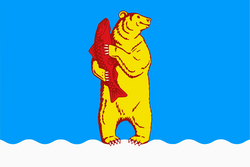 | A STANDING BEAR HOLDING A SALMON |
| Irkutsk | 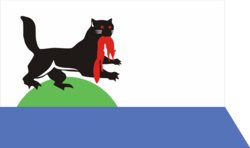 | A TIGER HOLDING A SABLE IN ITS MOUTH |
| Tell City | 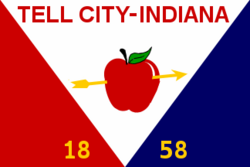 | AN APPLE WITH AN ARROW THROUGH IT |
| Buenos Aires | 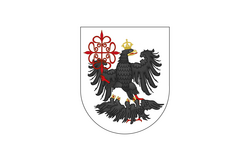 | AN EAGLE WEARING A CROWN WITH FOUR SMALL EAGLETS AT ITS FEET |
| Baku | 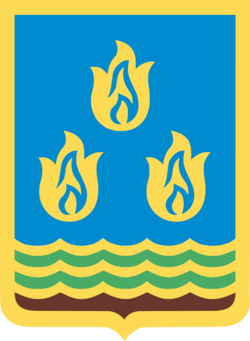 | THREE FLAMES ABOVE THREE WAVES |
| Cairo | 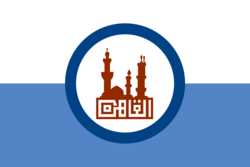 | THREE MINARETS ABOVE THE NAME "CAIRO" IN ARABIC |
| Detroit | 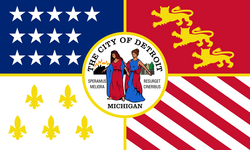 | TWO WOMEN STANDING IN FRONT OF FLAMING BUILDINGS AND NON-FLAMING BUILDINGS |
Author's Notes
This puzzle was written because I had encountered the tz database and thought it was an interesting, large, thorough, and (most importantly for puzzlehunts) canonical dataset that everyone has interacted with, whether they knew it or not. We were further spurred on by the discovery of “A literary appreciation of the Olson/Zoneinfo/tz database”, a blog post describing (appreciating) the long-form comments left by the maintainers researching and recording time-zone shifts at various points in history. If you haven't seen them, you should check them out, you can browse the development version of tz on GitHub.
From the start, we wanted to set this up as “probe the a black box” puzzle: it gives solvers the opportunity (a) to organically discover that time zones are not static (they're more political than technological) and (b) to use different approaches to identify them, whether it was annual DST transition dates or finding one-off time zone shifts.
To extract, we originally wanted to entangle this with another black-box puzzle with some other non-conventional historical dataset, but couldn't make the entanglement compelling. After giving up on that, we still had some trouble coming up with a thematic and interesting extraction from the time zone cities. We considered using various demographic information to match up cities or to index, but after we found the flags of Madrid, Spain, Tell City, Indiana, and Irkutsk, Russia, we decided that the city flags were too funny to pass up. We pretty much tried to choose the most interesting or funniest flags among the cities in the tz database. Hopefully they provided an interesting break from identifying time zones.
We knew that it might be a little limiting to query one date at a time, but we hoped that, with a good UI, a list of timezone data, and a plan, you would be able to find what you're looking for without too much trouble. To that end, we tried to make the UI as streamlined as possible; in the current version, you can hold down up or down in the year box to quickly scan through a single date in all years (our testsolvers were not nearly so fortunate).
You may have noticed that the form only allowed years between 1921 and 2021. The reason is that, in most time zones, before time was standardized, the tz database uses the "Local Mean (Solar) Time", which is essentially the city's longitude scaled to 24 hours. These time offsets are essentially unique and are relatively searchable, so we thought giving all of them would make this puzzle too uninteresting. We picked 1921 so that solvers would be able to see 2 such LMT offsets and could use those to break into the dataset. From testsolving, teams typically needed around 5 or 6 cities and flags to get enough of the cluephrase, so 2 (relatively) easy time zones seemed like a good amount to force solvers to dip their toes into the real dataset but not have to grind out too much time zone ID. In practice, I'm not sure if teams actually found flags as they went, so many teams may have identified many more than we intended to be necessary.
One important reason we factcheck puzzles is to make sure that “the facts are still true”, because datasets can grow or change between the time of puzzle writing and the time of the actual hunt. This was almost the case for this puzzle: one week before the hunt, tz database version 2021b was released, containing a few small changes and merging a few time zones. Scarier still, as hunt started, we discovered that version 2021c was released less than 3 hours before hunt start; in fact, the announcement was only sent after the hunt had already started. (For additional context: the first release's time zone mergers were somewhat controversial, which necessitated the quick follow-up release to revert those changes.) Packaged versions (such as the tzdata Python package we used) take some lead time to pull in upstream updates, so we thought we might have to build our own version from source. Fortunately, neither update affected any of the 11 time zones we clued (we're pretty sure), so we didn't have to modify anything and published the puzzle as is.